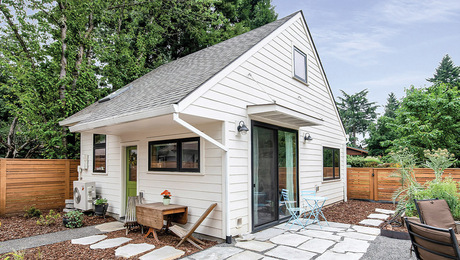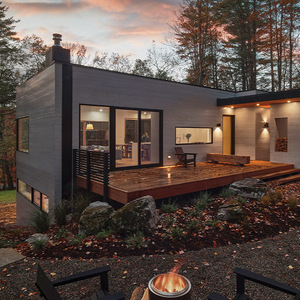In the new house that I have built, I have discovered that the sound transmission between an upstairs living area, and the room below ( a den) is intolerable. I can hear every word being spoken,drawers being opened and closed, even when the kettle comes to a boil!! I need help to remedy this. The floor of the room above consists of linoleum (forbo),on top of 1/4 plywood, on top of 3/4 inch TIG plywood, which is on top of TGI Silent Flooring Joists. This is stuffed with R28 batt insulation, and finished with 1/4 inch TIG pine which becomes the ceiling of the den below. The lighting in the den is comprised of 8 pot lights, which I think is acting like 8 megaphones. After all this time and money spent, I am dismayed at how unliveable this den is. Any suggestions? oh yeah…if this helps…the den is about 16 feet square with a 10 foot ceiling. Thanks!
Discussion Forum
Discussion Forum
Up Next
Video Shorts
Featured Story

Key proposals for the next edition of the International Residential Code tackle room sizes, stair specs, emergency egress, and deck guards, among other requirements.
Featured Video
Video: Build a Fireplace, Brick by BrickHighlights
"I have learned so much thanks to the searchable articles on the FHB website. I can confidently say that I expect to be a life-long subscriber." - M.K.
Fine Homebuilding Magazine
- Home Group
- Antique Trader
- Arts & Crafts Homes
- Bank Note Reporter
- Cabin Life
- Cuisine at Home
- Fine Gardening
- Fine Woodworking
- Green Building Advisor
- Garden Gate
- Horticulture
- Keep Craft Alive
- Log Home Living
- Military Trader/Vehicles
- Numismatic News
- Numismaster
- Old Cars Weekly
- Old House Journal
- Period Homes
- Popular Woodworking
- Script
- ShopNotes
- Sports Collectors Digest
- Threads
- Timber Home Living
- Traditional Building
- Woodsmith
- World Coin News
- Writer's Digest


















Replies
All those hard surfaces are allowing sound waves to tramsmitt thru them and are heard once they incounter air, ie in your den. The insulation is a good step but it is really the hard conection between the floor joist and your TIG pine ceiling. With 10 foot ceilings are you willing to give up a inch or two? I would remove the ceiling if you can to save then drop a grid of wires to suport a network of strapping and reinstall the cieling . the hard joint between the joist and the cieling is broken and the sound only gets to the air space above your pine and you watch the big game in peace and quiet. Good luck MIke
Do you think it would be an idea to put another material above the pine boards to muffle the sound? I would hate to remove the pine, and rehang it only to find it isn't quite enough. thanks for your thoughts.
HEY THERE!!! Well it is nice to know that there is so much good info out there and that people are willing to share what they know. I hope all goes well with what ever method you decide . Z channel high hat wire are all good breaking material . The one point I missed was the can lights nice holes for noise so I must agree that surface mount or wall scounces are preferable. Let us all know how it goes and what you decided.
Greetings from Mn mike
Any ductwork common to the den and the room above?
Remodeling Contractor just outside the Glass City.
Quittin' Time
no ductwork, just hotwater infloor heat.
This may help you.
Best set a pot of coffee.
http://irc.nrc-cnrc.gc.ca/bsi/85_E.html
Welcome to BT, first off.
Like most everybody else, my suspicion is that the ceiling needs seperation from the floor above. This does not mean losing the nice wood ceiling, just moving it down.
The floor above actually sounds well-made, with enough mass to get the most out of the radiant floor heating. That mass is trasmitting sound to the joist and then to the ceiling (the recessed cans are not helping, and may even, as you suspect, be "megaphoning" the sound to you.
On top of that, you are aclimated to "hear" the sound now. That's not your fault, just just the way annoying things are; they get your attention and keep it. So, you may need "more" fix than someone else. Not saying that the problem can't be fixed, just that you may have to guard against "least effort" equals "least relief" (which is not an argument for "more" work--just "better" work, in a horribly convoluted, illwritten, overqualified way . . . )
You are probably right about the potlights. They will act much like the hole in a guitar's soundboard. If you are looking for a cheap fix, forget it, anything you can do superficially at this point will only give you a minimal result. Think of your floor as a down-filled jacket with the zipper open.
Get rid of the potlights and the pine. Install 2 layers of ½" gyproc to the underside of the floor and hang a fire rated T-Bar cieling on wires below that. (fire rated T-Bars are much more solid than some home type systems). Add a center lighting fixture if you need to but you would be much better off with wall or floor lighting.
After you do all of this, you will still hear people walking above, drawers slamming and kettles boiling, but they won't be able to hear you screaming at them from below..
Everyone here is correct, the sound is transmitting through the solid members into the room below. The way to deaden this is to eliminate or substantially reduce the direct sound path through the floor. The insulation is helping a bunch. What is commonly done in our area is to add hat channel to the bottom side of the joists and then attach the finished ceiling to this. The hat channel breaks up the direct sound path. Also, maybe adding some sheet rock first and then the T&G might also deaden the sound by adding mass to the bottom side of the floor system
Good luck
Carpet anyone??
Carpet anyone??
On the den ceiling or the kitchen floor?
On the den ceiling or the kitchen floor?
Kitchen floor of course! Easier to clean up spills.
Insulation in the joist spaces only absorbs sound traveling through the air, and only sound that is travelling through the air where the insulation is. It will not affect structurally-transmitted sound, and it will not affect air-borne sound travelling other paths.
The first step is to analyze all the possible transmission paths. You have correctly identified three possibilities:
1. Sound is radiated by the pine ceiling into air in the joist spaces, and then to the floor of the room above, which radiates it into the room.
2. Sound is travelling freely through the air from the room below through the openings for the lights in the ceiling and from there to the floor of the room above, which radiates the sound into that room.
3. Sound is transferred from the pine ceiling into the joists, which transfer it to the floor of the room above, which radiates the sound into the room.
#1 can be eliminated, because of the insulation in the joist spaces. Fiberglass insulation is a very efficient absorber of sound in the frequencies generated by human voices, so if you are hearing conversation clearly the sound isn't getting to you by that path.
#2 is probably the major source of the problem, especially if the lights you chose require insulation to be kept away from the housing. As you suspect, these lights provide a convenient free-air path for sound to travel from the room below to the floor of the room above and from it into the room's air and your ears.
#3 is possible, but it takes a lot of energy to get such a massive structure as the one you describe vibrating violently enough to make it a sound radiator, unless the noise source just happens to be at a resonant frequency of the structure. Usually human voices and other air-borne sounds generated by household activities just aren't all that loud (i.e., are not all that high-energy). The major problem with structure-borne noise usually arises from noise sources that are acoustically coupled to the structure at the point of origin, such as a dresser that is against the wall. When you shove the drawer shut, the vibration of the dresser is transmitted directly to the wall and so on. Even if it isn't touching the wall, it's touching the floor, and that's touching the wall.
I would suggest an experiment: eliminate the free-air path through the lights by taping a piece of sound-absorbing material over all the openings, being sure to seal the entire perimeter of the material with the tape so there's no opening. If the noise transmission to the upstairs room is substantially reduced by doing this, you've identified the source of the problem, and the obvious solution is eliminate that free-air path somehow.
If stopping the light holes doesn't help much, the problem then is to decouple the rooms acoustically by interrupting the path of transmission through the structure. The ceiling would be the place to start, and the technique is to insert some vibration-damping material between the ceiling material and the joists, and to hold the edges of the ceiling a fraction of an inch away from the walls all around the perimeter. Several others have suggested ways of doing that. There's no need to to drop the ceiling by several inches. Increased air space between the ceiling and the floor above won't diminish structure-borne sound, and you've already insulated, the existing air space. All you're trying to do is interrupt the movement of vibration through the structure, or, if completely interrupting it isn't feasible, to damp the vibrations enough that what remains is too low-energy to make and audible sound.
Good luck.
If you do choose to decouple, I have had good results with " Z " track. It does the same job of furring as a typical U channel but is connected by only one leg.
I used it between the floors in my house, with a resiliant washer between the track and screw and resiliant shims between the track and joists above.
I also put "shelves" of drywall half way up the joists, supported by ledgers, cushioned by a resiliant material.
I hear footsteps and pounding when they get rowdy up there but nothing else.
First thing to do is make sure the sound is coming through the ceiling and not down through the walls. Use a stethoscope to determine where the most db's are coming through.
If as you suspect it's the ceiling, pop the pine T&G off the ceiling; staple two strips of Sill Seal to the bottom of each joist; screw 1x3 furring under that but don't compress the foam more than about 10-15%; then nail the T&G back onto the furring. Make sure the T&G doesn't touch the walls, and use crown or a big cove nailed only to the wall to hide the gap.
Replace your pot lights with insulation-contact rated units.
Let us know how it works out....
Dinosaur
'Y-a-tu de la justice dans ce maudit monde?